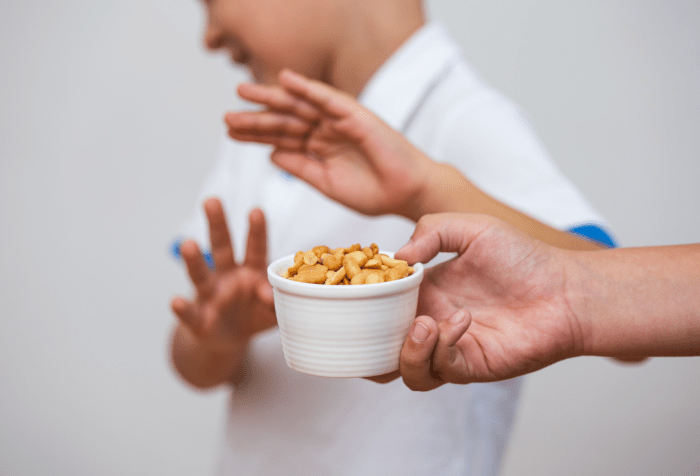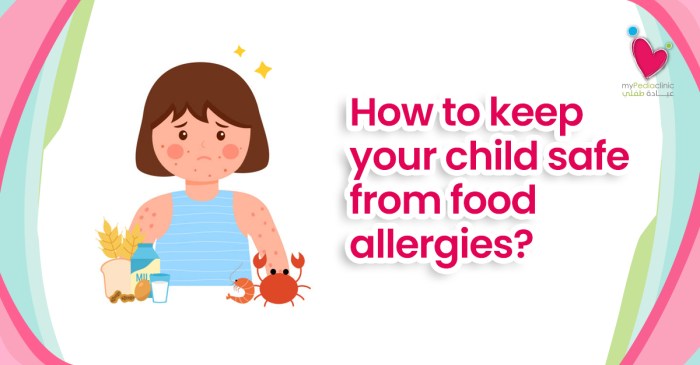
Food Allergies Are No Joke: Tips to Keep Your Children Safe
Food allergies are no joke tips to keep your children safe – Food allergies are no joke: tips to keep your children safe should be a top priority for every parent. Living with a food allergy can be a constant source of worry and stress, but with the right knowledge and strategies, you can navigate this challenge and ensure your child’s well-being.
This guide will equip you with the essential information you need to understand food allergies, prevent reactions, and keep your child safe.
Food allergies are a serious medical condition that can trigger life-threatening reactions. It’s crucial to recognize the signs and symptoms, learn how to manage your child’s allergies, and be prepared for emergencies. By understanding the basics of food allergies, you can create a safe and supportive environment for your child to thrive.
The Seriousness of Food Allergies

Food allergies are a serious health concern, particularly for children. While some reactions may be mild, others can be life-threatening, requiring immediate medical attention. Understanding the potential dangers and learning how to manage food allergies is crucial for ensuring the safety and well-being of children.
The Dangers of Food Allergies
Food allergies occur when the body’s immune system mistakenly identifies a harmless food protein as a threat. This triggers an allergic reaction, leading to the release of histamine and other chemicals. The severity of reactions can vary greatly, ranging from mild symptoms like hives or itching to severe, life-threatening anaphylaxis.
Examples of Severe Allergic Reactions
Anaphylaxis is a severe allergic reaction that can affect multiple body systems, leading to a range of symptoms, including:
- Swelling of the face, lips, tongue, and throat
- Difficulty breathing, wheezing, or shortness of breath
- Hives, itching, or redness
- Nausea, vomiting, or diarrhea
- Dizziness, lightheadedness, or fainting
- Rapid heartbeat
- Loss of consciousness
If left untreated, anaphylaxis can lead to:
- Respiratory failure:Difficulty breathing can progress to complete airway closure, leading to oxygen deprivation and potential death.
- Cardiovascular collapse:Anaphylaxis can cause a drop in blood pressure and heart rate, leading to shock and potentially fatal cardiac arrest.
The Importance of Early Diagnosis and Management
Early diagnosis is essential for managing food allergies. It allows parents and caregivers to implement appropriate strategies to prevent exposure and minimize the risk of allergic reactions. A healthcare professional can perform allergy testing to identify the specific food triggers and recommend a personalized management plan.
Understanding Food Allergies
Food allergies are a serious health concern for many children. While food intolerances and food allergies may seem similar, they are different. Understanding the differences between the two is crucial for ensuring your child’s safety.
Food Intolerance vs. Food Allergy
Food intolerance and food allergy are distinct conditions. Food intolerance involves a digestive issue that causes discomfort after consuming certain foods. However, it does not trigger an immune response. Food allergy, on the other hand, is an immune system reaction to specific proteins in food.
The immune system mistakenly identifies these proteins as harmful, leading to the release of histamine and other chemicals. This triggers a range of symptoms, from mild to life-threatening.
Common Food Allergens for Children
Food allergies are more common in children than in adults. The most common food allergens for children are:
- Milk
- Eggs
- Peanuts
- Tree nuts (such as almonds, walnuts, and cashews)
- Soy
- Wheat
- Fish
- Shellfish
These allergens are responsible for the majority of food allergy reactions in children.
How Food Allergies Develop
Food allergies can develop at any age, even in infancy. In some cases, food allergies may be inherited from parents. However, there is no single cause for food allergies.
Several factors can contribute to their development, including genetics, exposure to allergens, and gut health.
While the exact mechanism is not fully understood, research suggests that early exposure to certain foods may help prevent the development of food allergies.
Prevention and Avoidance Strategies
Preventing allergic reactions in children is a crucial aspect of managing food allergies. This involves understanding the specific allergens, implementing avoidance strategies, and being vigilant about cross-contamination. By adopting a proactive approach, parents and caregivers can significantly reduce the risk of allergic reactions and ensure their children’s safety.
Food allergies are a serious concern for many families, and it’s crucial to take every precaution to keep your kids safe. Always read labels carefully, and if you’re unsure about an ingredient, err on the side of caution and ask.
Even seemingly harmless things like birthday parties can pose risks, so it’s important to be prepared. For example, if a child’s umbrella breaks at a picnic, you can make a parachute out of a broken umbrella to keep them entertained while you assess the situation.
But when it comes to food allergies, it’s best to be prepared and avoid any potential triggers. A little extra effort can go a long way in ensuring your child’s safety and well-being.
Allergen-Specific Avoidance Strategies
| Allergen | Avoidance Strategies | Cross-Contamination Prevention | Resources |
|---|---|---|---|
| Milk |
|
|
|
| Eggs |
|
|
|
| Peanuts |
|
|
|
| Tree Nuts |
|
|
|
Safe Food Handling Practices
Food allergies can be a serious concern, especially for children. While it’s crucial to avoid trigger foods, it’s equally important to practice safe food handling practices to prevent accidental exposure. This involves being mindful of cross-contamination and understanding how to read food labels and prepare meals safely.
Reading Food Labels
Food labels are your primary defense against accidental exposure to allergens. They contain essential information about ingredients, potential allergens, and nutritional content.
- Always read the ingredient list carefully.Pay close attention to common allergens, such as milk, eggs, peanuts, tree nuts, soy, wheat, fish, and shellfish. Look for words like “may contain” or “traces of” as these indicate potential cross-contamination.
- Check for allergen declarations.Many food labels will explicitly state whether the product contains common allergens. Look for phrases like “Contains: Peanuts” or “Allergen Information: Contains Milk.”
- Be aware of hidden allergens.Some ingredients may not be obvious, such as “natural flavors” or “modified food starch.” These can sometimes contain hidden allergens.
Safe Food Preparation and Storage
Cross-contamination is a significant risk factor for food allergies. Even trace amounts of an allergen can trigger a severe reaction. Here are some tips for safe food preparation and storage:
- Use separate cutting boards and utensils for different food groups.For example, use a dedicated cutting board for allergen-free foods and a separate one for foods containing allergens.
- Wash hands thoroughly with soap and water before and after handling food.This helps prevent the spread of allergens from one food to another.
- Clean and sanitize all surfaces, utensils, and appliances after preparing food.This includes the kitchen sink, countertops, and cooking equipment.
- Store allergen-free foods separately from foods containing allergens.This prevents cross-contamination during storage.
Dining Out Safely
Dining out can be challenging when managing food allergies. It’s essential to communicate with restaurant staff clearly and effectively to ensure your child’s safety.
- Inform the server about your child’s allergies before ordering.Be specific about the allergens your child is allergic to.
- Ask about the preparation process.Inquire about how the food is prepared, cooked, and served.
- Request separate utensils and cooking areas.This minimizes the risk of cross-contamination.
- Double-check the ingredients of dishes before ordering.Even if a dish appears safe, it’s always best to confirm with the server or chef.
- Consider bringing your own food if necessary.If you’re unsure about the restaurant’s ability to accommodate your child’s allergies, it’s always safe to bring a meal from home.
Emergency Preparedness

Food allergies can be life-threatening, and it’s crucial to be prepared for emergencies. Having an epinephrine auto-injector readily available is vital in case of an allergic reaction.
Food allergies are a serious matter, and keeping your children safe requires vigilance. It’s not just about avoiding obvious triggers; it’s about understanding cross-contamination and reading labels carefully. For example, if you’re thinking of baking a batch of those delicious 33 neighbor Christmas gift moose tracks for your neighbors, make sure you’re using allergy-friendly ingredients and keeping separate utensils and surfaces for preparing those treats.
It’s always best to err on the side of caution when it comes to your child’s health.
Epinephrine Auto-Injectors
Epinephrine auto-injectors, such as EpiPens, are essential for managing severe allergic reactions. They deliver a dose of epinephrine, a hormone that helps constrict blood vessels and open airways, counteracting the effects of anaphylaxis. It’s crucial to have an up-to-date epinephrine auto-injector readily available at all times.
Food allergies are no joke, and keeping your kids safe is a top priority. It’s important to be prepared, especially when you’re out and about. A stylish and functional fabulous fabric scarf can actually be a lifesaver! It can be used to cover food that might trigger an allergic reaction, and it’s a great way to keep your little one warm and comfortable.
Always remember to check labels and talk to your child’s doctor for specific advice on managing food allergies.
Emergency Preparedness Checklist
Here’s a checklist to ensure you’re prepared for a potential allergic reaction:
- Always carry two epinephrine auto-injectors, one for immediate use and a spare.
- Ensure the epinephrine auto-injectors are not expired. Check the expiration date regularly.
- Store epinephrine auto-injectors in a cool, dry place, away from direct sunlight.
- Teach your child how to use the epinephrine auto-injector, and practice administering it with a trainer.
- Inform your child’s school, daycare, and other caregivers about their food allergies and how to administer epinephrine.
- Carry a medical identification bracelet or necklace indicating your child’s food allergies and the need for epinephrine.
- Keep a list of emergency contacts, including your child’s doctor, allergist, and emergency services.
Administering Epinephrine Auto-Injectors
In case of an allergic reaction, follow these steps to administer epinephrine:
- Call emergency services immediately.
- Remove the auto-injector from its protective case.
- Hold the auto-injector with the orange tip facing upwards.
- Find a large muscle on your child’s thigh, preferably on the outer side.
- Press the orange tip firmly against the muscle and inject the epinephrine.
- Hold the auto-injector in place for at least 10 seconds to ensure the full dose is delivered.
- Remove the auto-injector and massage the injection site for a few seconds.
- Monitor your child closely and be prepared to administer a second dose if necessary.
Supporting Children with Food Allergies
Living with a food allergy can be challenging for children, impacting their daily lives in various ways. It’s crucial to understand the emotional and social challenges they face and provide them with the support they need to navigate these situations confidently.
Understanding the Emotional and Social Challenges
Food allergies can significantly impact a child’s emotional well-being and social interactions. The constant worry of accidental exposure, the fear of being different, and the feeling of being excluded can lead to anxiety, depression, and low self-esteem.
Helping Children Navigate Social Situations
It’s essential to equip children with the tools and strategies to navigate social situations confidently. This includes:
- Open Communication:Encourage open communication about their allergies with friends, teachers, and other adults. This can help prevent misunderstandings and ensure their safety.
- Role-Playing:Practice scenarios involving food at school, parties, or restaurants. This can help them feel prepared and confident in handling these situations.
- Social Support:Connect with other families with food allergies to build a support network and share experiences. This can help children feel less alone and learn from others.
Building Confidence and Self-Advocacy Skills, Food allergies are no joke tips to keep your children safe
Empowering children to advocate for themselves is crucial for their safety and well-being. This can be achieved through:
- Educating Others:Help them understand their allergies and the importance of avoiding certain foods. They can create presentations, posters, or brochures to share with their classmates and teachers.
- Developing Assertiveness:Encourage them to speak up for themselves and ask for help when needed. This can involve asking for allergen-free options at school events or requesting a separate table at a restaurant.
- Positive Reinforcement:Celebrate their successes in managing their allergies and advocating for themselves. This can help build their confidence and self-esteem.
Seeking Professional Help: Food Allergies Are No Joke Tips To Keep Your Children Safe

Navigating the world of food allergies can feel overwhelming, especially for parents. Seeking professional guidance is crucial for ensuring your child’s safety and well-being.
Consulting with an Allergist
An allergist is a medical professional specializing in diagnosing and managing allergies. They play a vital role in helping families understand their child’s specific allergies and develop personalized management plans.
Available Resources for Families
Numerous resources are available to support families dealing with food allergies.
Organizations and Support Groups
- Food Allergy Research & Education (FARE):FARE is a leading nonprofit organization dedicated to food allergy research, education, advocacy, and support. They provide a wealth of information, resources, and support for families, including online communities, educational materials, and advocacy initiatives.
- The Asthma and Allergy Foundation of America (AAFA):AAFA is a national organization that offers resources and support for individuals and families affected by allergies, including food allergies. They provide information on diagnosis, management, and advocacy.
- Local Food Allergy Support Groups:Many communities have local support groups for families dealing with food allergies. These groups offer a safe space for parents to connect, share experiences, and receive support from others who understand their challenges.
Online Resources
- Websites and Blogs:Many websites and blogs provide valuable information on food allergies, including diagnosis, management, recipes, and tips for navigating social situations.
- Mobile Apps:Several mobile apps are available to help manage food allergies, such as tracking food ingredients, finding allergy-friendly restaurants, and managing emergency contact information.
Allergy Testing and Management Plans
Allergy testing is essential for confirming a food allergy and identifying the specific allergens that trigger reactions.
Types of Allergy Testing
- Skin Prick Test:This involves pricking the skin with a small amount of the suspected allergen. A reaction, such as a wheal (a raised bump), indicates an allergy.
- Blood Test:Blood tests measure the levels of antibodies (immunoglobulin E or IgE) to specific allergens. Higher levels of IgE indicate an allergy.
- Food Challenge:In some cases, a food challenge may be performed under medical supervision. This involves gradually introducing the suspected allergen to determine the lowest dose that triggers a reaction.
Management Plans
Once a food allergy is diagnosed, an allergist will develop a personalized management plan.
Components of a Management Plan
- Avoidance:The most important aspect of managing food allergies is strict avoidance of the triggering allergen.
- Label Reading:Carefully reading food labels to identify potential allergens is crucial.
- Safe Food Handling Practices:Implementing safe food handling practices at home and in public settings helps prevent cross-contamination.
- Emergency Preparedness:Having an emergency plan in place, including access to epinephrine (such as an EpiPen), is vital for managing severe allergic reactions.
- Education:Educating family members, caregivers, and teachers about the child’s food allergies is essential for ensuring their safety.






